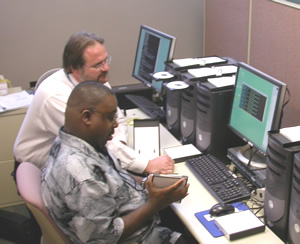NLS DEFINES ITS NEEDS FOR A DIGITAL ASSET MANAGEMENT SYSTEM

The National Library Service for the Blind and Physically Handicapped (NLS) is committed to ensuring that its digital talking-book (DTB) collection is easily accessible. Organization is a key in facilitating usability. During the next year, NLS will focus on developing a Digital Asset Management System (DAMS) to arrange and store its digital titles. NLS is currently defining the system's requirements, which will guide the selection of a contractor to build the system.
Frank Kurt Cylke, NLS director, perceives that "the Digital Asset Management System is a major piece of the digital project. In order to manage the digital collection with the same efficiency as the cassette collection, we are taking advantage of new technology that will support digital management."
DAMS consists of multiple functions that operate together to form a system. It is essentially advanced software that electronically manages large volumes of information or data like the digital talking-book collection for maximum efficiency and ease of handling. DAMS will also engage in various functions central to sustaining a digital collection. NLS automation officer Michael Martys, DAMS project manager, is currently working on defining requirements.
HOW IT WILL WORK
DAMS will serve many needs. In addition to managing the collection's content, the system must also facilitate collection accessibility and some aspects of DTB production.
"DAMS is a complex system with a simple goal-to make DTBs easily accessible to NLS patrons and librarians," says Martys. "All of its various functions ultimately work together to achieve that end."
DAMS will support online access to the collection, estimated to be in excess of about 20,000 titles. When patrons submit a title download request, the software will communicate with other NLS computer information systems to fill that order.
Another important DAMS task will be to archive the digital collection. The archive will include both a playable version of the DTB and the master recordings. Efficient archiving provides organized, secure, and centralized storage.
According to Martys, some of the project's top challenges have been finding a storage mode that could accommodate NLS's sizable collection as well as afford users immediate access to the collection. It's a tall order, but DAMS will be customized in an effort to meet those needs.
It will also serve the communication and production needs of a duplication-on-demand (DOD) system, in which titles are duplicated by request at special centers. The program will collect special orders from network libraries and forward them to DOD centers for fulfillment. The DOD centers will then download the requested titles from the DAMS and duplicate copies onto flash-memory cartridges for the libraries.
DAMS will also provide NLS personnel with statistics and data on its internal operations. NLS will use this information to monitor and maintain the system and ensure that it runs smoothly.
NEXT STEPS
DAMS will be a focal point in the NLS digital project over the next two years. Once Martys and his team finish defining the system's requirements, they will begin the important work of finding the right contractor to do the job. That search will continue through the end of the year. In early 2007, focus will shift to installing DAMS.
PILOT PROJECT TO TEST DAMS FUNCTIONS
Recently NLS began a research and development project to create software that will emulate some of the functions of the Digital Asset Management System (DAMS). The project will test fundamental concepts involved in the development of DAMS. Facilitating title download, production, distribution, and archiving are among DAMS functions that will be tested.
Loading NLS's digital collection, stored on an estimated 160,000 CDs, onto a computer is one of the greatest challenges automation officer Michael Martys and his team face. "If we stacked these CDs one on top of the other, the pile would tower nearly three hundred feet over the Washington Monument," said Martys. NLS engineers are considering the possibility of using robots to help in this process.
Once the titles are loaded and checked by a specially designed computer program, they are encoded with AMR-WB+, a software tool that can compress files to one-thirtieth of their original size with virtually no perceptible loss of sound quality. After the files are loaded and encoded, the system applies copyright protection and converts the files into ZIP format for easy download from the Web.
